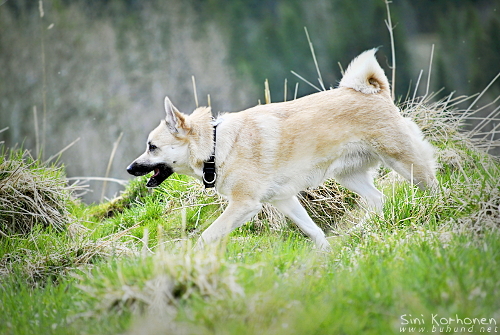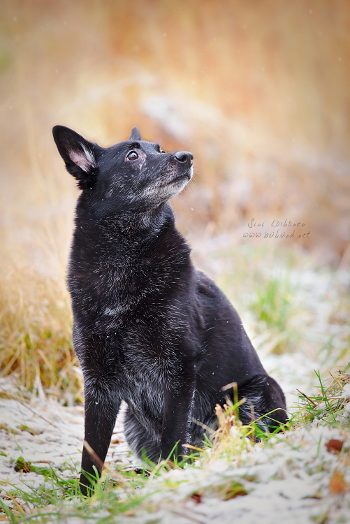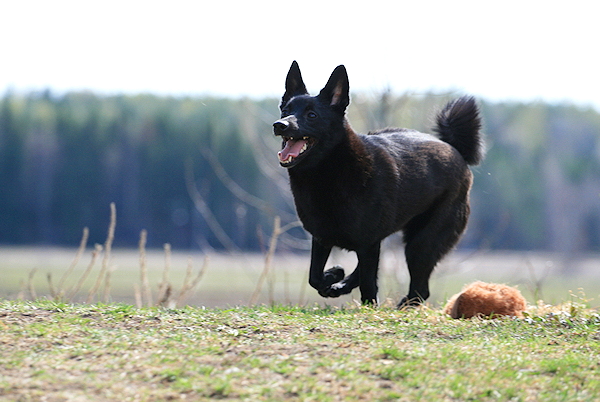Norwegian Buhund
Buhund as a breed is quite unknown to public. In Finland buhunds are few and a breed that looks like a regular mixed-breed spitz is not very memorable.

Appearance
Buhunds are small mid-sized spitzes with curly tail and black (dominant black) or wheaten (sable) color. Females are about 41-45cm and males 43-47cm tall.Wheaten color can be redder, yellower, lighter, darker, brighter, shadowed... There are many tones. Often buhunds also have some white on their chest or paws, sometimes even at their neck or face. This white usually blends to wheaten color so you can't see it but blacks of course always show their white parts. Sometimes wheaten have so strong counter-shading that it almost looks like urajiro like japanese dog breeds have.
There have also been born long haired and black&tan buhunds. Neither of which is accepted by breed standard.
Buhunds also have a colour called "varglett" ("/wolf sable"), which is not the actual wolf colour of agouti-locus but just very strongly shaded sable. Possibly some of them are carriers of tanpoints. This colour is also against the breed standard, only moderate amount of black-tipped hairs are allowed.
In the past there also was a variety called "dwarf buhund" ("dvergbuhund"), which was just a small-sized buhund. At around 1930 they even had their own class at the shows but since then they have been removed from breed standards. I have seen some photos that look like some buhunds could have had a short-legged gene like the short-legged Karelian bear dogs or Norwegian elkhounds.
Worldwide there are not much buhunds and somewhat small population size puts its own challenges to a breeder.

Health
Lots of buhunds have a so called buhund cataract (pulverulent nuclear cataract) that causes opacities to the affected eye. Fortunately PNK is quite harmless form of cataract and it has not seen as so severe as a problem that it would remove the dog from breeding. A dog with PNK can be mated with a dog without it.Sadly buhunds also have other types of hereditary cataracts and they are not so harmless. Dogs with other cataracts are not used for breeding but a huge amount of the buhunds are carriers for at least one type of serious cataract. Also sometimes these cataracts can be found only from older dogs. Eyes can be clear when the dog is bred and later on the cataract is found. This is why every buhund should have regular eye examinations troughout their lives.
Breed also has moderate amounts of hip dysplasia. According to Finnish breeding guides, C-hips can be bred with A-hips. As a rough guide this is ok since there are no hip indexes available for buhunds in any country.
Finnish insurance companies usually place buhunds in their lowest pay class because of their good health and longevity. Bad luck with an individual is always possible but quite often buhunds live long without any major problems. 10+ years is not at all impossible age and often these seniors are in so good condition they can even be shown.
Biggest causes of death for buhunds are different cancers, traffic accidents and "old age".
Character
Buhunds have a character that's a mix of basic sheepdog and hunting spitz. They are less eager to please their owner than the "regular sheepdog" but not as headstrong as the hunting spitzes. They were historically bred to work independently far away from their shepherd, bringing sheep from the mountains. Buhund is a basic dog, jack-of-all-trades. They can do almost everything but do not excel in anything. Nowadays they are used as hunting dogs for elk and birds, herding sheep, assistance dogs, alerting dog and many of the dog hobbies (for example agility, obedience, rally-obedience, tracking/trailing etc.)Buhunds are also very intelligent. If they want something, they can learn to get it. My Freia opens even locked doors (wasn't fun to find her from the hallway, door to my apartment wide open). Buhunds would like to follow their families everywhere and often when outside they come to check that you are still there.
Buhunds tend to be people-friendly and animal-friendly. They often go along nicely with other domestic animals that belong to their family. Unfamiliar dogs can either be their friends, not interesting enough to even notice or hateful creatures. So don't assume every buhund will be best friends with any unfamiliar dogs. Especially in their own home. A buhund can be fine with other dogs outside but defend their own home.
 When training a young buhund you should pay close attention to behaving on a leash. It's ridiculously easy to get a buhund that barks to everything including cars, bikers, people, other dogs etc. They can even try to chase cars, bikers and runners and since it's very dangerous, you should never allow your bu to do it.
When training a young buhund you should pay close attention to behaving on a leash. It's ridiculously easy to get a buhund that barks to everything including cars, bikers, people, other dogs etc. They can even try to chase cars, bikers and runners and since it's very dangerous, you should never allow your bu to do it.
Also if you want to keep your bu off-leash, you should start training it from the very start. When they learn basics as a puppy it's easier to keep up the good behavior when they grow up. But there are buhunds that just can not be kept off-leash. A buhund can have so much hunting instincts that they will follow every single rabbit trail they find. Though most of the time they will only leave when they see the rabbit and stay only as long as they can see it.


